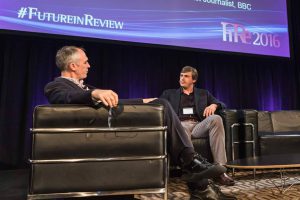Detecting Bio-Flows for Predictive Health
Data flow patterns within the body, detected via common biomarkers hold potentially accessible information regarding future health conditions, argues Benjamin Smarr, National Institutes of Health (NIH) Postdoctoral Fellow at University of California, Berkeley.
During a discussion at the 2016 Future In Review 2016 conference, Benjamin introduced pioneering research regarding circadian rhythms and the flow of information that can transform the medical industry.
“If you think about your body as the world,” Smarr said, “and all the parts of your body are providing flows to each other, you can analyze the body in a similar was to other more mainstream data flows.”
His research suggests that biological flows have a specific wavelength that if measured and analyzed, can predict specific health conditions in the future.
In his lab at UC Berkeley, Smarr has been measuring body temperature in mice to predict successful pregnancies. When mating mice for lab tests, Smarr jokes the current process entails “pairing the mice, turning on some jazz music, and waiting for biology to happen.”. To determine whether a pregnancy is legitimate, the mouse is weighed after two weeks of a three week term, and if the weight is higher than the average weight of a mouse, then the pregnancy is successful offspring can be within a week.
Smarr’s research, on the other hand, allows him to predict pregnancies within 8-12 hours after mating. Using body temperature as a biomarker, Smarr analyzes a flow of data to be able to predict with 100% accuracy whether a mouse will come to full term.
“This has significant implications for the medical industry,” he said. “If we can understand how the internal systems are impacting temperature, then we can potentially access a database of information through a single biomarker.”
The implications of these findings are significant. As we begin to find correlations between patterns in biomarkers and diseases, illnesses, etc., we can begin to prescribe remedies before symptoms are even detected.
“We can begin to answer the question ‘Am I going to get cancer later in life?,’ because we can detect certain flows within the body now,” said Smarr.
To discover more or read other articles from the conference, visit StratNews.com or our Medium blog.
